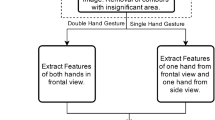Abstract
Needs and new technologies always inspire people to make new ways to interact with machines. This interaction can be for a specific purpose or a framework which can be applied to many applications. Sign language recognition is a very important area where an easiness in interaction with human or machine will help a lot of people. At this time, India has 2.8M people who can’t speak or can’t hear properly. This paper targets Indian sign recognition area based on dynamic hand gesture recognition techniques in real-time scenario. The captured video was converted to HSV color space for pre-processing and then segmentation was done based on skin pixels. Also Depth information was used in parallel to get more accurate results. Hu-Moments and motion trajectory were extracted from the image frames and the classification of gestures was done by Support Vector Machine. The system was tested with webcam as well as with MS Kinect. This type of system would be helpful in teaching and communication of hearing impaired persons.
Similar content being viewed by others
References
R. A. Bolt, “Put that there—voice and gesture at the graphics interface,” in Proc. 7th Annu. Conf. on Computer Graphics and Interactive Techniques (ACM, New York, 1980), pp. 262–270.
X. Cao and R. Balakrishnan, “VisionWand: Interaction techniques for large displays using a passive wand tracked in 3D,” in Proc. 16th Annu. ACM Symp. on User Interface Software and Technology (Vancouver, 2003), pp. 173–182.
W. T. freeman and C. D. Weissman, “Television control by hand gestures,” in Proc. IEEE Int. Workshop on Automatic Face and Gesture Recognition (Zurich, June 1995).
I. V., Pavlovic, R. Sharma, and T. S. Huang, “Visual interpretation of hand gestures for human-computer interaction: a review,” IEEE Trans. Pattern Anal. Mach. Intellig. 19 7, 677–695 (1997).
A. Erol, G. Bebis, M. Nicolescu, R. D. Boyle, and X. Twombly, “Vision-based hand pose estimation: A review,” Comput. Vision Image Understand. 108, 52–73 (2007).
Chih-Lyang Hwang and Hai-Wu Lee, “The command control by hand gesture with Hu and contour sequence moments and probability neural network,” in Proc. IEEE Int. Conf. on Systems, Man, and Cybernetics (SMC) (Anchorage, 2011), pp. 2056–2061.
Liu Yun and Zhang Peng, “An automatic hand gesture recognition system based on Viola-Jones method and SVMs,” in Proc. 2nd Int. Workshop on Computer Science and Engineering (Qingdao, 2009), pp. 72–76.
A. Chaudhary, J. L. Raheja, and K. Das, “A vision based real time system to control remote robotic hand fingers,” in Proc. IEEE Int. Conf. on Computer Control and Automation (Jeju Island, May 1–3, 2011), pp. 118–122.
D. Lee and S. Lee, “Vision-based finger action recognition by angle detection and contour analysis,” Electron. Telecommun. Res. Inst. J. 33 3, 415–422 (2011).
Te-Hsiu Sun, “K-cosine corner detection,” J. Comput. 3 7, 16–22 (2008).
J. L. Raheja, A. Chaudhary, and K. Singal, “Tracking of fingertips and centre of palm using KINECT,” in Proc. 3rd IEEE Int. Conf. on Computational Intelligence, Modelling and Simulation (Langkawi, Sept. 20–22, 2011), pp. 248–252.
Nianjun Liu and B. C. Brian Lovell, “Gesture classification using hidden Markov models and Viterbi path counting,” in Proc. 7th Digital Image Computing: Techniques and Applications Conf. (Sydney, Dec. 10–12, 2003).
M. Elmezain, A. Al-Hamadi, R. Niese, and B. Michaelis, “A robust method for hand tracking using mean-shift algorithm and Kalman filter in stereo color image sequences,” Int. J. Inf. Commun. Eng. 6 3, 131–135 (2010).
A. Chaudhary, M. B. L. Manasa, and J. L. Raheja, “Light invariant neuro-vision system for elder/sick people to express their needs into lingual description,” in Proc. Microsoft Research India’s Annu. Research Symp. TechVista (Kolkata, Jan. 20, 2012).
Yen-Ting Chen and Kuo-Tsung Tseng, “Multipleangle hand gesture recognition by fusing SVM classifiers,” in Proc. 3rd Annu. IEEE Conf. on Automation Science and Engineering (Scottsdale, AZ, Sept. 22–25, 2007), pp. 527–530.
G. R. Naik D. Kant, and K. Jayadeva, “Twin SVM for gesture classification using the surface electromyogram,” IEEE Trans. Inf. Technol. Biomed. 14 2, 301–308 (2010).
A. Chaudhary, J. L. Raheja, K. Das, and S. Raheja, A Survey on Hand Gesture Recognition in Context of Soft Computing (Springer, Berlin, Heidelberg, 2011), pp. 46–55.
J. L. Raheja, K. Das, and A. Chaudhary, “Fingertip detection: a fast method with natural hand,” Int. J. Embedded Syst. Comput. Eng. 3 2, 85–89 (2011).
M. Hu, “Visual pattern recognition by moment invariants,” IRE Trans. Inf. Theory 8 2, 179–187 (1962).
http://censusindiagovin/Census_And_You/disabled_ populationaspx
Author information
Authors and Affiliations
Corresponding author
Additional information
The article is published in the original.
Jagdish Lal Raheja received his Master of Technology from Indian Institute of Technology, Kharagpur, India and Ph.D. from Technical University of Munich, Germany. Currently he is Senior Principal Scientist at Digital Systems Group, Central Electronics Engineering Research Institute (CEERI), Pilani, India. He has been a DAAD fellow and visiting scientist to many countries. He has published more than 100 papers in International Journals and peer reviewed conferences. His areas of research interest are digital image processing, embedded systems and human computer interface. He is in the editorial board of several international journals and also reviewer for many reputed conferences. He has been Principal investigator in many important real life projects.
Anand Mishra is working toward his Master of Technology in Instrumentation Engineering from School of Instrumentation, Devi Ahilya Vishwavidyalaya, Indore, INDIA. His areas of research interest are digital image processing, artificial intelligence, VLSI systems, and digital communication.
Ankit Chaudhary received his Master of Engineering in Computer Science and Engineering from Birla Institute of Technology and Science, Pilani, and Ph.D. in Computer Vision, from Central Electronics Engineering Research Institute. His areas of research interest are computer vision, digital image processing, artificial intelligence and robotics. He is member of IEEE and also serves in the editorial board at many international journals.
Rights and permissions
About this article
Cite this article
Raheja, J.L., Mishra, A. & Chaudhary, A. Indian sign language recognition using SVM. Pattern Recognit. Image Anal. 26, 434–441 (2016). https://doi.org/10.1134/S1054661816020164
Received:
Published:
Issue Date:
DOI: https://doi.org/10.1134/S1054661816020164




